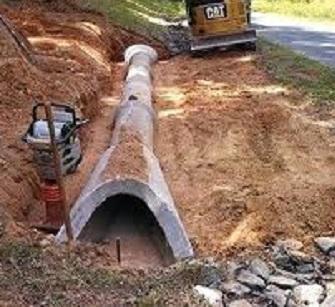Precision Pad Construction for Stable Foundations
Culvert Installment Facilitated: Step-by-Step Guide for Success
Setting up culverts may seem like an uncomplicated job, however guaranteeing an effective outcome needs careful preparation and execution. From selecting the appropriate culvert size to incorporating correct drainage steps, each action in the setup process plays a critical role in the capability and longevity of the culvert system. By complying with a methodical approach and focusing on key information, the installment can proceed smoothly, decreasing prospective issues down the line. Remain tuned to uncover the crucial actions and factors to consider that can make culvert installment a seamless and successful venture.
Selecting the Right Culvert Size
Choosing the ideal culvert dimension is important for ensuring efficient water flow and structural honesty in culvert setup jobs - Pad Construction. The dimension of the culvert directly influences the flow capacity of water through the structure. A culvert that is as well tiny can cause flooding and overflow, while one that is too large may result in decreased water speed, potentially triggering sediment accumulation and clogs
To identify the ideal culvert size, factors such as the watershed area, height flow rates, and hydraulic effectiveness demand to be meticulously considered. Calculations based upon these criteria help in choosing a dimension that can appropriately handle the expected water volume while decreasing the danger of obstructions and structural failure.
It is important to consult design guidelines and criteria to ensure that the chosen culvert size meets the task requirements and neighborhood regulations (Pad Construction). By picking the appropriate culvert dimension, job managers can optimize water circulation, prevent possible issues, and boost the total effectiveness and longevity of the culvert installation
Preparing the Setup Site
Effective culvert installation necessitates precise preparation of the installation website to make sure ideal structural assistance and capability. Prior to starting the installation procedure, it is important to get rid of the website of any type of debris, plants, or blockages that might impede the culvert's placement. Making sure a degree structure is essential for the correct alignment and stability of the culvert. This might entail grading the website to develop a smooth, even surface that can appropriately sustain the weight of the culvert and any kind of expected lots. In addition, appropriate compaction of the soil below the culvert is required to protect against resolving or shifting in time.
Moreover, it is necessary to take into consideration aspects such as dirt composition, groundwater degrees, and environmental influences when preparing the installation site. Performing a thorough website analysis can aid recognize any type of possible obstacles or dangers that may influence the culvert's efficiency. By putting in the time to prepare the installation site appropriately, you can aid guarantee a successful culvert installation that meets architectural requirements and ensures long-term performance.
Positioning the Culvert Correctly

The quality at which the culvert is positioned is More about the author critical for maintaining a correct slope for water circulation. A gradual slope assists avoid merging and promotes reliable water drainage. Furthermore, the culvert should be oriented properly to ensure that the inlet and outlet are in the appropriate locations. This positioning is important for the culvert to work properly in managing water flow.
Backfilling and Condensing the Dirt
Proper backfilling and compaction of the soil around the culvert is important to make sure stability and prevent prospective problems in the future. When the culvert is appropriately positioned, the following vital step is to backfill the area around it with ideal material. The backfill material should be complimentary from rocks, particles, and natural issue to avoid damages to the culvert. It is advised to utilize granular material such as sand or gravel for backfilling, as it offers excellent drain and compaction properties.
After putting the backfill material, it is necessary to compact it in layers of consistent density. Making use of a compactor or a mechanical tamper, compact the dirt delicately to avoid damaging the culvert. Compaction aids in lowering the chances of settlement and guarantees consistent support around the culvert. It is vital to small the dirt uniformly on all sides of the culvert to maintain its structural honesty.
Correct backfilling and compaction not just offer security to the culvert yet also aid in protecting against dirt erosion and preserving the durability of the culvert system.
Guaranteeing Correct Water Drainage Assimilation
Integrating efficient drainage remedies plays a crucial function in the general capability and long life of culvert installments. Appropriate water drainage assimilation is important for managing water flow, preventing disintegration, and guaranteeing the architectural integrity of the culvert system. To accomplish this, it is important to design a detailed water drainage strategy that considers variables such as the quantity of water anticipated, the topography of the area, and the type of soil existing.

Furthermore, including attributes like erosion control procedures, such as riprap or greenery, can better boost the efficiency of the drain system. By very carefully preparing and carrying out these drain solutions, culvert installments can function efficiently and withstand the test of time.
Conclusion
To conclude, appropriate culvert installation is crucial for preserving effective drain systems. By choosing the right culvert dimension, preparing the installment site, about his placing the culvert top article properly, backfilling and compacting the dirt, and ensuring proper water drainage integration, success can be accomplished. Complying with these actions will certainly help guarantee the longevity and efficiency of the culvert, ultimately contributing to the total success of the drain system.